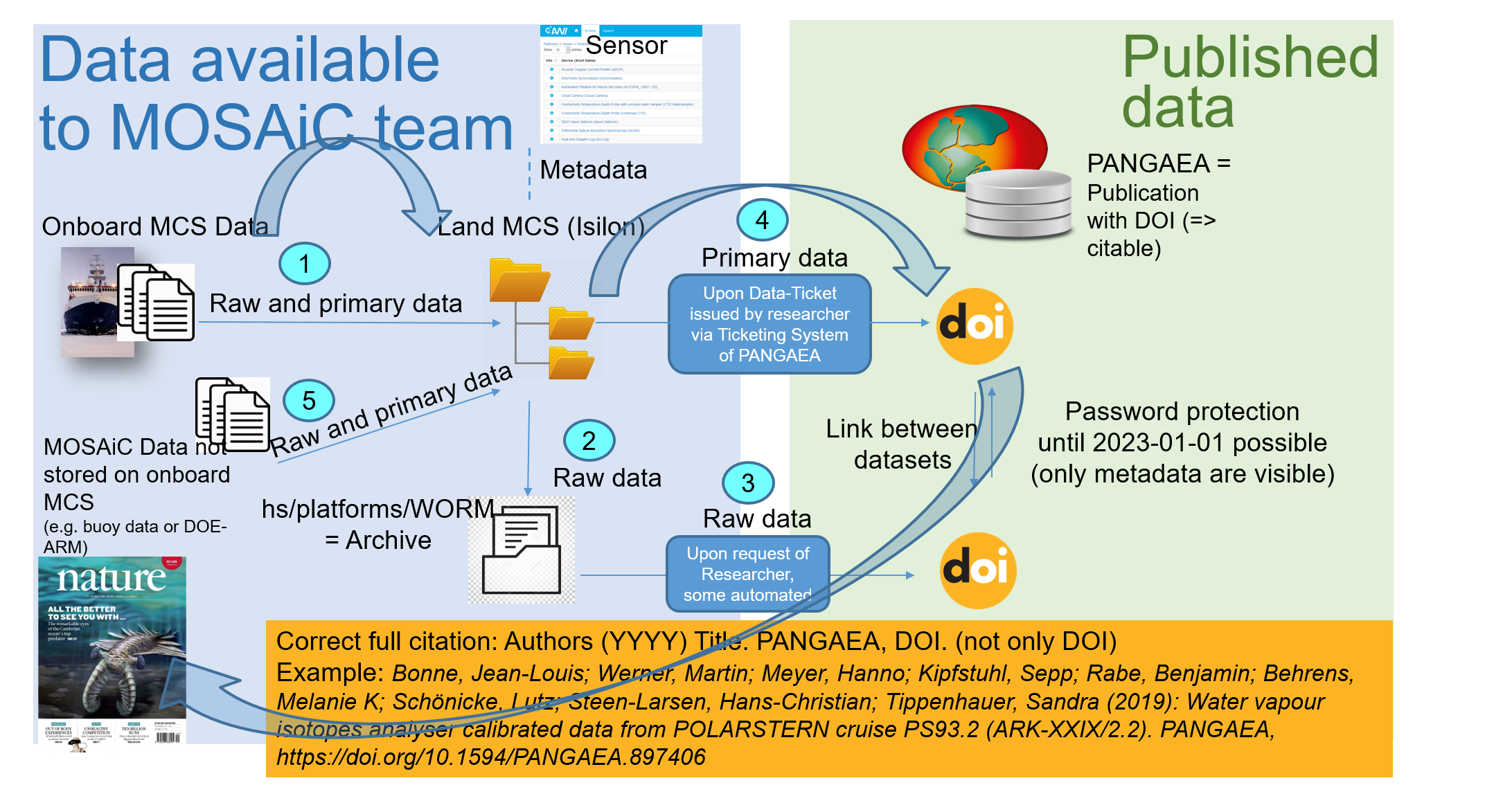Page History
...
How do I approach data publication?Row data / Primary data publication workflow
Datasets in PANGAEA may be archived as stand-alone publications of data (e.g., https://doi.org/10.1594/PANGAEA.753658) or as supplements to an article (e.g., https://doi.org/10.1594/PANGAEA.846130). Data can be submitted to and published in PANGAEA with access restrictions in place for a predefined period (until article publication, or during an embargo period). Metadata must be submitted together with the data. Minimal requirements are:
Any documentation (e.g., MOSAiC Standard operating procedures, MSOPs) helping to understand the data can and should be linked to the dataset(s). If no persistent link to the documents can be provided, PANGAEA can archive the documents permanently alongside the data. The MOSAiC Device operation ID(s) / Events list is available after the end of each leg from PANGAEA page https://www.pangaea.de/expeditions/byproject/MOSAiC (can be found for viewing or download under "Event list: " link). Within the data table, parameters (table header) should be submitted with full names and units. Data submitted in the form of videos, photos, geoTIFF, shape files, netCDF, sgy, etc. will be archived as is (e.g., https://doi.org/10.1594/PANGAEA.865445). More information on data submission can be found in https://wiki.pangaea.de/wiki/Data_submission.
Data submission to PANGAEAAre you planning to share your research data? That is a great idea. If you publish your data with PANGAEA, we will provide a long-term data archiving service using the FAIR principles:
With PANGAEA your data will be found by others, re-used, and cited appropriately – ensuring that you get the deserved credit for it. Data submission is easy. All you need is your data, some additional information called metadata, and the willingness to open up your data to the world. By granting access to your data in a citable format you can greatly increase the impact of your scientific work. PANGAEA is a fully curated data repository, so once you take the initial step, we will help you personally through the further submission process. To make the submission process smoother, you can work through the following checklist to see if you have everything ready:
With all this prepared, you can start your submission. Just go to www.pangaea.de and sign in. If you are not a user yet you need to register with your name and E-Mail address, or ideally your ORCID ID. An ORCID ID is a unique identifier for academic authors. To find more about ORCiD, visit www.orcid.org. This login can later also be used to access your password protected dataset during the review of your data publication. After signing up, you will receive a link via email to activate your account and sign in. Once logged in, click on “Submit data” and a data submission form will open. In this form, you can enter the information from your checklist, including
You can choose the license under which you plan to share your data. We recommend CC-BY, which is suitable for scientific data reuse. Finally and most importantly you need to attach your dataset files. If your data files are larger than 100 MB we can provide an upload link for large files up to 10 GB per file. Please indicate this in the Description-field. Once you think you have entered all necessary information and data files, you can click on “Create”. Do not worry if you are uncertain about some fields or content, you will still be able to make final adjustments during the following steps and with support of your data curator. First the submission passes an editorial review to make sure the data submission fits the scope of PANGAEA and is complete. If questions remain, we will get back to you. Then the submission will be assigned to a data curator who will lead you through the further process. After we’ve imported your data to PANGAEA, you’ll be asked to proofread your dataset, which is then “in review”. We lead you through this iterative process with our ticket system until the data submission is complete and approved by you. Once the dataset is approved, the digital object identifier, DOI, is registered and with that the dataset is officially published and citable. If the related manuscript has not been published yet, a moratorium on access and publication can be put in place. At the same time, PANGAEA can provide a temporary key to enable access to your datasets for example for anonymous reviewers. To assure that the FAIR principles are met and that we can apply high quality standards, we provide professional and personalized data curation by skilled curators for every complete submission. This requires time. Thus, submit your data as early as possible to PANGAEA and we can keep your data under a moratorium until your publication has been accepted. By sharing your data in PANGAEA you will increase the impact of your research data and receive proper credit for it. See, it’s not difficult at all! Get your data ready and let’s get started at www.pangaea.de. |
